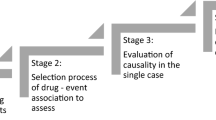Summary
Identifying the adverse effects of drugs, thus transforming adverse events into adverse drug reactions, is a useful and necessary but complicated task. Objective proof of a causal relationship between a drug and a specific event is quite exceptional. In most cases, this relationship remains subjective and is no more than inner conviction.
Several means are at our disposal to achieve causal assessment: spontaneous reporting, clinical trials, cohorts with and without controls, and case-control studies, with each having advantages and limitations. The search for causality in pharmacovigilance is a necessary scientific goal, but a high degree of suspicion may be all that is necessary to withdraw a drug from the market if it is suspected of causing serious adverse effects.
Similar content being viewed by others
References
Arme P. Analyse d’incidence en pharmacovigilance: application à la notification spontanée, Arme P. Editions, Bordeaux, 1991
Auriche M. Approche bayésienne de l’imputabilité des phénomènes indésirables aux médicaments. Thérapie 40: 301–306, 1985
Begaud B, Evreux JCL, Jouglard JC, Lagier G. Imputabilité des effets inattendus ou toxiques des médicaments: actualisation de la méthode utilisée en France. Thérapie 40: 111–114, 1985
Böttiger LE, Westerholm B. Drug-induced blood dyscrasias in Sweden. British Medical Journal 3: 339, 1973
Bryant CD, Norman GR. Expressions of probability: words and numbers. New England Journal of Medicine 302: 411, 1980
Committee of Principal Investigators. WHO co-operative trial on primary prevention of ischaemic heart-disease using clofibrate to lower serum cholesterol: mortality follow-up. Lancet 2: 279–385, 1980
Feinstein AR. In Clinical epidemiology, WB Saunders Co., Philadelphia, 1985
Hutchinson TA, Leventhal JM, Kramer MS, Kirch FE, Lipman AG, et al. An algorithm for the operational assessment of adverse drug reactions: II. Demonstration of reproducibility and validity. Journal of the American Medical Association 242: 633–638, 1979
Karen FE, Lasagna L. Towards the operational identification of adverse drug reactions. Clinical Pharmacology and Therapeutics 21: 247–254, 1977
Kenney RM. Between never and always. New England Journal of Medicine 305: 1097–1098, 1981
Kramer MS. Clinical epidemiology and biostatistics. Springer-Verlag, Berlin, 1988
Kramer MS, Leventhal JM, Hutchinson TA, Feinstein AR. An algorithm for the operational assessment of adverse drug reactions: I. Background, description and instructions for use. Journal of the American Medical Association 242: 623–632, 1979
Lane DA, Kramer MS, Hutchinson TA, Joner JK, Naranjo C. The causality assessment of adverse drug reactions using a Bayesian approach. Pharmaceutical Medicine 2: 265–283, 1987
Lewis JA. Postmarketing surveillance: how many patients?. Trends in Pharmacological Science 2: 93–94, 1981
Loupi E, Ponchon AC, Ventre JJ, Descotes J, Evreux JCL. Le rechallenge est-il nécessaire à une imputabilité maximale? Valeur comparée dans sept méthodes d’imputabilité. Thérapie 39: 461–466, 1984
Marion MH, Simon P. Signification des adverbes utilisés pour indiquer la fréquence des effets secondaires des médicaments. Thérapie 39: 47–63, 1984
Nakao MA, Axelrod A. Numbers are better than words. American Journal of Medicine 74: 1061–1065, 1983
Pere JC, Godin MH, Begaud B, Haramburu H, Albin H. Sensitivity and specificy of imputability criteria: study and comparison of these indices for seven ADRs’ assessment procedures. Thérapie 40: 307–312, 1985
Rossi AC, Knapp DE. Discovery of new ADR; a review of the FDA spontaneous reporting system. Journal of the American Medical Association 252: 1030–1033, 1984
Sackett DL, Gent M. Controversy in counting and attributing events in clinical trials. New England Journal of Medicine 301: 1410–1412, 1979
Sarkies N. What do we mean by ‘usually’? Lancet 1: 1305, 1980
Schwartz D, Lellouch J. Explanation and pragmatic attitudes in therapeutic trials. Journal of Chronic Diseases 20: 637–48, 1967
Selvidge JE. Assigning probabilities to rare events, Thesis, Harvard University, DBA, Business Administration, 1972
Stephens MDB. The detection of new adverse drug reactions, 2nd ed., Macmillan, London, 1989
Toogood JH. What do we mean by ‘usually’? Lancet 1: 1094, 1980
Venning GR. Identification of adverse reactions to new drugs: 1. What have been the important adverse reactions since thalidomide? British Medical Journal 286: 199–202, 1983a
Venning GR. Identification of adverse reactions to new drugs: 2. How were 18 important adverse reactions discovered and with what delays. British Medica] Journal 286: 289–292, 365–368, 1983b
Venning GR. Identification of adverse reactions to new drugs: 3. Alerting processes and early warning systems. British Medical Journal 286: 450–460, 1983c
Venning GR. Identification of adverse reactions to new drugs: 4. Verification of suspected adverse reactions. British Medical Journal 286: 544–547, 1983d
Author information
Authors and Affiliations
Rights and permissions
About this article
Cite this article
Auriche, M., Loupi, E. Does Proof of Causality Ever Exist in Pharmacovigilance?. Drug-Safety 9, 230–235 (1993). https://doi.org/10.2165/00002018-199309030-00008
Published:
Issue Date:
DOI: https://doi.org/10.2165/00002018-199309030-00008




